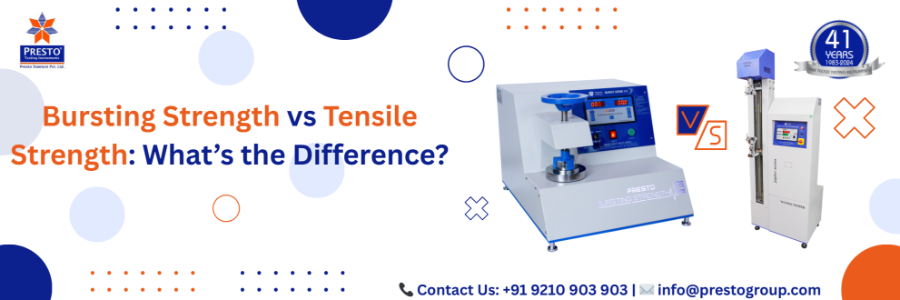

In the field of material and packaging testing, knowing how strong a material is plays an important role. Two key types of strength tests are bursting strength and tensile strength. Both show how well a material can resist outside forces, but they are different in how they are tested, measured, and used.
In this blog, we’ll clearly explain the difference between bursting strength and tensile strength, talk about how each test is done, and guide you on which one is better for your material—whether it’s paper, carton boxes, fabric, or other packaging materials.
Bursting strength is the ability of a material to withstand pressure applied in all directions before rupturing. It is especially important for materials like paper, cardboard, fabric, and packaging films that can be subjected to multidirectional stress during transportation or use.
The Bursting Strength Tester is used to measure this property. In this test, the material is clamped and subjected to increasing hydraulic or pneumatic pressure via a rubber diaphragm until it bursts. The maximum pressure at which it bursts is recorded as its bursting strength.
Applications:
Tensile strength means how strong a material is when you pull it. It shows how much stretching force the material can handle before it breaks. This test is important for things that are pulled or stretched during use.
A Tensile Strength Tester (also called a tensile test machine) checks this by holding both ends of the material and slowly pulling it until it breaks. The machine notes the force needed to break it—that’s the tensile strength.
Applications:
Here’s a simple comparison to help you differentiate between the two:
| Property | Bursting Strength | Tensile Strength |
| Definition | Resistance to pressure from all sides | Resistance to pulling/stretching force |
| Direction of Force | Multidirectional | Unidirectional |
| Testing Equipment | Bursting Strength Tester | Tensile Strength Tester |
| Measured In | kg/cm² or psi | N/mm² or MPa |
| Applications | Paper, cartons, fabrics | Plastics, metals, textiles |
| Testing Standard | ASTM D3786, ISO 2758 | ASTM D882, ISO 527 |
| Failure Mode | Rupture due to pressure | Break due to tension |
For packaging materials, both bursting test and tensile test play crucial roles in ensuring product safety during transit and storage.
When a carton box is stacked or dropped, pressure can come from any direction. A carton box bursting strength testing machine ensures that boxes can resist sudden pressure surges and won’t burst open, leading to product damage.
Plastic films or sealing tapes used in packaging are often pulled or stretched. Poor tensile strength can result in tear or failure, leading to compromised packaging integrity.
To achieve reliable results, you need to use advanced and calibrated testing machines:
In textiles, especially in safety clothing and industrial fabrics, bursting strength is more relevant than tensile strength. That’s because fabric gets stressed from various directions during wear.
Test Method:
One of the standard methods for fabrics is the hydraulic diaphragm method (ASTM D3786) where a round fabric sample is placed on a diaphragm and hydraulic pressure is increased until the fabric bursts.
This is especially crucial for:
A lab bursting strength tester is widely used in quality control labs of packaging manufacturers. These machines are essential to:
Many manufacturers use digital bursting testers with memory storage and printout features for compliance reporting.
| If your material is... | Use this test |
| Corrugated box or paperboard | Bursting Strength Test |
| Plastic film or sealing tape | Tensile Strength Test |
| Woven or knitted fabric | Bursting Strength Test |
| Metal wire or rod | Tensile Strength Test |
If you are a packaging manufacturer, ideally you should use both tests as part of your QA process, since each provides different insights into material performance.
Q1: What is a good bursting strength for corrugated boxes?
A good bursting strength for corrugated boxes depends on the application but typically ranges from 16 to 32 kg/cm². For heavy-duty packaging, this number can go even higher.
Q2: Can a tensile test be used instead of a bursting test?
No. Tensile tests and bursting tests measure different material behaviors. Substituting one for the other can result in inaccurate performance assessment, especially in packaging materials.
Q3: Is bursting strength applicable to plastic materials?
Generally, bursting strength is not suitable for most plastics unless they are in sheet form and subjected to multidirectional pressure. Tensile testing is preferred for plastics.
Q4: How often should packaging companies conduct bursting and tensile tests?
It’s recommended to test each new batch of packaging material. For critical applications, daily QA testing with lab equipment is ideal.
Understanding the difference between burst strength vs tensile strength is critical for choosing the right material for your product. Whether you're manufacturing carton boxes, fabrics, or plastic films, using the appropriate strength testing machines ensures your packaging holds up under pressure—literally.
Investing in precise testing instruments like a Bursting Strength Tester or a Tensile Strength Tester not only helps in quality assurance but also protects your brand reputation by reducing damages and returns.
Presto Group offers world-class strength testing machines including the carton box bursting strength testing machine, fabric bursting strength testers, and tensile test machines for every industrial need.
Call Now: +91 9210 903 903
Email: info@prestogroup.com
Connect with us for your business enquiries. Generally, we respond within one or two working days.